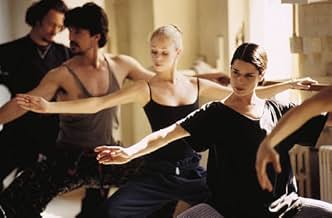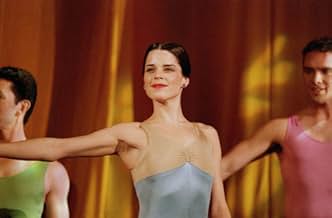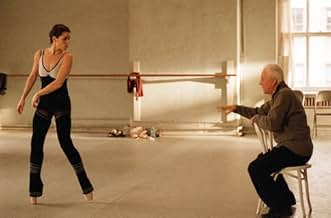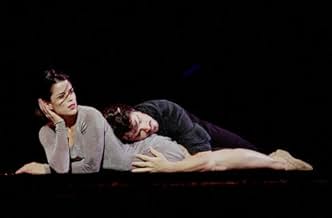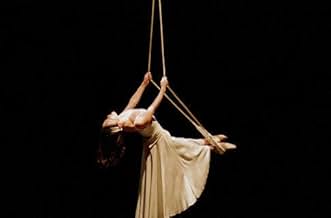IMDb RATING
6.2/10
7K
YOUR RATING
A young ballet dancer is poised to become the principal performer in a group of ballet dancers.A young ballet dancer is poised to become the principal performer in a group of ballet dancers.A young ballet dancer is poised to become the principal performer in a group of ballet dancers.
- Awards
- 2 nominations total
Barbara E. Robertson
- Harriet
- (as Barbara Robertson)
Davis C. Robertson
- Alec - Joffrey Dancer
- (as Davis Robertson)
Featured reviews
Ugh. The problem with The Company is that it's not a Robert Altman film. His touch is evident in the filmmaking and fly-on-the-Wall feel of the movie, but it's not his movie. It's Neve Campbell's, who wrote, produced, and starred in it. Campbell spent years with the national ballet and this movie was a labor of that passion. However, that is precisely where it goes wrong. It shoots for the wrong audience. Dancers will likely love this movie but they are the choir. They know how a dance company works, the back dealing and politics. They don't need this movie. The rest of us don't learn anything, or at least learn just enough to know that professional dancing is a horrible way to live. The dancing was beautiful, including Neve's, although she doesn't look quite as polished as her back ups in the company, but the characters were shallow and you are never given anything to grab onto to care about any of them. The only ones you root for the ones who are injured or fired so they can get out of that horrible horrible place. Such a disappointment on so many levels. The only thing that does come off well is the Joffrey. You actually leave the theater wondering if the Ballet company underwrote the production as a marketing expense.
The Company is far below the level of Robert Altman's best efforts. In contrast with Gosford Park's endlessly fascinating chatter weaving an intricate web of intrigues and secrets, there's much stretching and dancing, but very little delving into the backgrounds or relationships of the principals. There's hardly what you could call a plot. There are only a few strong characters. All you really get to hold things together somehow or provide some sense of continuity is a series of things that go wrong:
(1) Among the many dance `numbers,' the one that stands out is the first, an outdoor performance featuring the Hollywood actress Neve Campbell (Scream 1,2, and 3, Wild Things), a trained dancer and the force behind the making of the whole film. A thunderstorm comes to buffet the audience and the dancers. The dancers bravely go on and the dance -- so we're told, anyway -- is a triumph. The entire sequence is dominated by a sense of impending disaster. A slippery stage could have meant serious injury. One also wonders about damage to valuable string instruments being played in the open to accompany the dance. All this is extremely distracting and excruciating to watch. Altman does succeed though in giving us a sense of what performances are like from the company's point of view -- struggles with physical problems; successful efforts (at best) to avert disaster.
(2) An injury forces a new lead dancer to give up a role. This happens twice. We realize that dancers constantly face injury, or, as often, are dangerously in denial that they have one.
(3) Another sort of injury prevents a dancer from performing the whole of a `number.' This happens to Neve Campbell at the end of the movie. It's just an arm injury, so not career-threatening, but enough to require a quick replacement by a stand-in.
(4) A young man is replaced, but only for the latter part of a dance he's in -- because his energy seems to flag at that point in the performance. This nonetheless results in a terribly bruised ego for the young man and his union rep promises to lodge a formal protest. We get a sense of the constant threats to the ego in such an arbitrarily run system, along with the surprising news that union redress may be available in such cases.
(5) One of the guys in the company takes a new girlfriend. This time again it's Neve Campbell who's the `injured' one, and at a post-performance celebration she delivers an `I was the last to know' speech to the bad boy. I saw nods of agreement from dancerly-looking audience members during this moment.
(6) The aging female lead dancer - she's 43 - repeatedly protests about too-challenging new dances and refuses to make changes in the choreography of old ones. This potentially interesting, possibly tragic, theme of aging in what is really one of the world's most demanding sports is, however, only briefly touched on.
(7) An argument occurs between the director and one dancer, who hates choreography of a dance he's in, in which men wearing skirts `give birth' -- and the director instantly reverses what he said about how to perform this moment the day before. The director is adamant, the dancer has lost his cool, and the conversation breaks down. He frequently ends unsatisfactory conversations by dismissing his interlocutor. The director's rule is autocratic and rarely challenged. However the company does get mild revenge toward the end in a mock restaging of the season's events at a party.
All this adds up to something so generic and uninteresting as emotional truth or human experience that you are deeply grateful when at least the main dancer character, Neve Campbell, gets hooked up with a cook boyfriend, the intriguing James Franco. You're thankful for one young male movie star in the piece, because the real dancer `actors' - as usual - have very little presence or ability as actors. All James Franco gets to do is smile, kiss the girl, take off his shirt, and break some eggs. He does these things with lots of charm and charisma, but these are just crumbs tossed to us. The point however seems to be that dancers don't have time for much more than quick sex; it's like smoking a cigarette, something squeezed in.
Altman's casts are usually heavy with talent. This time there are only three leads, Campbell, McDowell, and Franco. Ironically only the least used, Franco, has any real appeal.
Ms. Campbell is little more than bustling and workmanlike. She has a few minutes with her pushy stage mother that provide some sense of relationships outside the company, but it's not enough.
You will have a lot of trouble with this movie if you don't like Malcolm McDowell. As the `Italian' company director Alberto Altonelli, he is brusque, bossy, obtrusive -- really just a flaming a**hole with a lot of power to abuse. Is this how dance companies work? Where's the genius? Why does young Franco have more charisma and sex appeal? And what's this about a ceremony in which the blatantly English McDowell gets an award for `honoring the Italian-American community'? Okay; let's pretend that he's Italian. But do we have to pretend he has no English accent? If that weren't bad enough, his little speech about not discouraging their sons from becoming ballet dancers is jarring and crude, like all his speeches: it's the height of ingratitude, and you wonder how anyone so undiplomatic could get money for his company. Is it just possible that McDowell is a jarring and crude actor? His performance is wooden and unsubtle. All he has to qualify for this role is forcefulness. Granted, he has that. But his scenes are nothing but irritations.
This is, at best, a generic treatment of an American ballet company. But it fails even on that level. How come none of the male dancers, not one, is shown to be gay? Isn't that a bit unrealistic about the culture of dance? Why the pretense that they're all straight, vying to have sex with the female dancers in the company?
Neve's partner after their triumph in the rain has a private improv session unwinding to a Bach solo cello suite. It's rather fun - and would have worked better if it had been allowed to run by itself and not been constantly intercut with the scene of Neve in her apartment - a huge Hollywood-style creation right by the `El' with a glam bath. The improvised Bach session makes you realize that Flash Dance was better than this. There was another movie about a dance company, featuring real dancers again, that was better than this. It had a bit more plot, and perhaps better dances; the people seemed a tad more real as people - and yet it wasn't a great movie. Altman's film has spectacular dance sequences at the beginning and the end but they're just staging, not great dance, and they're window dressing to cover up the emptiness of the whole production.
If you love dance and/or Altman you'll doubtless have to see this picture, but you won't be watching a particularly memorable ballet movie or getting Altman even at his average level.
(1) Among the many dance `numbers,' the one that stands out is the first, an outdoor performance featuring the Hollywood actress Neve Campbell (Scream 1,2, and 3, Wild Things), a trained dancer and the force behind the making of the whole film. A thunderstorm comes to buffet the audience and the dancers. The dancers bravely go on and the dance -- so we're told, anyway -- is a triumph. The entire sequence is dominated by a sense of impending disaster. A slippery stage could have meant serious injury. One also wonders about damage to valuable string instruments being played in the open to accompany the dance. All this is extremely distracting and excruciating to watch. Altman does succeed though in giving us a sense of what performances are like from the company's point of view -- struggles with physical problems; successful efforts (at best) to avert disaster.
(2) An injury forces a new lead dancer to give up a role. This happens twice. We realize that dancers constantly face injury, or, as often, are dangerously in denial that they have one.
(3) Another sort of injury prevents a dancer from performing the whole of a `number.' This happens to Neve Campbell at the end of the movie. It's just an arm injury, so not career-threatening, but enough to require a quick replacement by a stand-in.
(4) A young man is replaced, but only for the latter part of a dance he's in -- because his energy seems to flag at that point in the performance. This nonetheless results in a terribly bruised ego for the young man and his union rep promises to lodge a formal protest. We get a sense of the constant threats to the ego in such an arbitrarily run system, along with the surprising news that union redress may be available in such cases.
(5) One of the guys in the company takes a new girlfriend. This time again it's Neve Campbell who's the `injured' one, and at a post-performance celebration she delivers an `I was the last to know' speech to the bad boy. I saw nods of agreement from dancerly-looking audience members during this moment.
(6) The aging female lead dancer - she's 43 - repeatedly protests about too-challenging new dances and refuses to make changes in the choreography of old ones. This potentially interesting, possibly tragic, theme of aging in what is really one of the world's most demanding sports is, however, only briefly touched on.
(7) An argument occurs between the director and one dancer, who hates choreography of a dance he's in, in which men wearing skirts `give birth' -- and the director instantly reverses what he said about how to perform this moment the day before. The director is adamant, the dancer has lost his cool, and the conversation breaks down. He frequently ends unsatisfactory conversations by dismissing his interlocutor. The director's rule is autocratic and rarely challenged. However the company does get mild revenge toward the end in a mock restaging of the season's events at a party.
All this adds up to something so generic and uninteresting as emotional truth or human experience that you are deeply grateful when at least the main dancer character, Neve Campbell, gets hooked up with a cook boyfriend, the intriguing James Franco. You're thankful for one young male movie star in the piece, because the real dancer `actors' - as usual - have very little presence or ability as actors. All James Franco gets to do is smile, kiss the girl, take off his shirt, and break some eggs. He does these things with lots of charm and charisma, but these are just crumbs tossed to us. The point however seems to be that dancers don't have time for much more than quick sex; it's like smoking a cigarette, something squeezed in.
Altman's casts are usually heavy with talent. This time there are only three leads, Campbell, McDowell, and Franco. Ironically only the least used, Franco, has any real appeal.
Ms. Campbell is little more than bustling and workmanlike. She has a few minutes with her pushy stage mother that provide some sense of relationships outside the company, but it's not enough.
You will have a lot of trouble with this movie if you don't like Malcolm McDowell. As the `Italian' company director Alberto Altonelli, he is brusque, bossy, obtrusive -- really just a flaming a**hole with a lot of power to abuse. Is this how dance companies work? Where's the genius? Why does young Franco have more charisma and sex appeal? And what's this about a ceremony in which the blatantly English McDowell gets an award for `honoring the Italian-American community'? Okay; let's pretend that he's Italian. But do we have to pretend he has no English accent? If that weren't bad enough, his little speech about not discouraging their sons from becoming ballet dancers is jarring and crude, like all his speeches: it's the height of ingratitude, and you wonder how anyone so undiplomatic could get money for his company. Is it just possible that McDowell is a jarring and crude actor? His performance is wooden and unsubtle. All he has to qualify for this role is forcefulness. Granted, he has that. But his scenes are nothing but irritations.
This is, at best, a generic treatment of an American ballet company. But it fails even on that level. How come none of the male dancers, not one, is shown to be gay? Isn't that a bit unrealistic about the culture of dance? Why the pretense that they're all straight, vying to have sex with the female dancers in the company?
Neve's partner after their triumph in the rain has a private improv session unwinding to a Bach solo cello suite. It's rather fun - and would have worked better if it had been allowed to run by itself and not been constantly intercut with the scene of Neve in her apartment - a huge Hollywood-style creation right by the `El' with a glam bath. The improvised Bach session makes you realize that Flash Dance was better than this. There was another movie about a dance company, featuring real dancers again, that was better than this. It had a bit more plot, and perhaps better dances; the people seemed a tad more real as people - and yet it wasn't a great movie. Altman's film has spectacular dance sequences at the beginning and the end but they're just staging, not great dance, and they're window dressing to cover up the emptiness of the whole production.
If you love dance and/or Altman you'll doubtless have to see this picture, but you won't be watching a particularly memorable ballet movie or getting Altman even at his average level.
Lets hope that Altman makes films for another 20 years and that he stays as adventuresome as he currently is.
In 'The Long Goodbye' Altman invented a rather new camera stance, literally asking the actors to improvise staging and having the camera discovering them.
It took a few decades for him to get back to such experiments with 'Gosford.' Now he takes it even further with perhaps the purest problem in film cinematography: how do you film dance?
Forget that this features Campbell in a vanity role: she is good enough and doesn't detract. Forget about any modicum of plot: there isn't any. And unlike 'Nashville' or the similarly selfreferential 'Player' there is no cynical commentary.
The commentary itself is selfreferential this time. Yes, this time the center of the film is how 'Mr A' orchestrates movement and images. This is most of all about himself, and is far, far more intelligent and subtle than say, 'Blowup.'
But along the way, you get possibly the best dance experience on film. That's because they've been able to use many cameras. There are not as many as 'Dancer in the Dark,' but each camera dances, engages with the dance and the dance of people and objects around the dance. So we get four layers of dance: the actual ballet, the orchestration of people around the production, the dancing cameras (enhanced by non-radical appearing radical editing) and the dance within the mind of Mr A who encourages, follows and captures them all.
Ted's Evaluation -- 3 of 3: Worth watching.
In 'The Long Goodbye' Altman invented a rather new camera stance, literally asking the actors to improvise staging and having the camera discovering them.
It took a few decades for him to get back to such experiments with 'Gosford.' Now he takes it even further with perhaps the purest problem in film cinematography: how do you film dance?
Forget that this features Campbell in a vanity role: she is good enough and doesn't detract. Forget about any modicum of plot: there isn't any. And unlike 'Nashville' or the similarly selfreferential 'Player' there is no cynical commentary.
The commentary itself is selfreferential this time. Yes, this time the center of the film is how 'Mr A' orchestrates movement and images. This is most of all about himself, and is far, far more intelligent and subtle than say, 'Blowup.'
But along the way, you get possibly the best dance experience on film. That's because they've been able to use many cameras. There are not as many as 'Dancer in the Dark,' but each camera dances, engages with the dance and the dance of people and objects around the dance. So we get four layers of dance: the actual ballet, the orchestration of people around the production, the dancing cameras (enhanced by non-radical appearing radical editing) and the dance within the mind of Mr A who encourages, follows and captures them all.
Ted's Evaluation -- 3 of 3: Worth watching.
I'm no dance critic, but. . . I was very disappointed with the choice of "The Blue Snake" as the ultimate and climactic "number" in "The Company". To me, it really stood out as the least interesting and most cliched of all the dances in the film. Those outrageous costumes! That "Ice Capades" choreography! Altman & Co. really ought to have chosen a piece that would have shown the Joffrey's more adventuresome side.
I went into this film knowing that it was a "dance movie" with minimal storyline, and I was still disappointed. It's not a good sign when I start looking at my watch halfway through a film. It doesn't bother me that a "dance film" eschews the Melodrama of "The Turning Point" or "A Chorus Line." But "The Company" also eschews Interest! There was basically nothing to "hang onto" outside the dance sequences. Only Ry (Neve Campbell's character) was given any appreciable screentime, and aside from a few quiet moments, she wasn't given very much to do.
Okay, I admit that I liked one dramatic scene a lot: a flirtatious moment between Ry and Josh - the chef who looks like a male model - which takes place in a dive bar. There should have been more scenes like that.
I rate the film a 6 - dramatically disappointing, while the quality of the dance sequences varies from sublime to ridiculous.
I went into this film knowing that it was a "dance movie" with minimal storyline, and I was still disappointed. It's not a good sign when I start looking at my watch halfway through a film. It doesn't bother me that a "dance film" eschews the Melodrama of "The Turning Point" or "A Chorus Line." But "The Company" also eschews Interest! There was basically nothing to "hang onto" outside the dance sequences. Only Ry (Neve Campbell's character) was given any appreciable screentime, and aside from a few quiet moments, she wasn't given very much to do.
Okay, I admit that I liked one dramatic scene a lot: a flirtatious moment between Ry and Josh - the chef who looks like a male model - which takes place in a dive bar. There should have been more scenes like that.
I rate the film a 6 - dramatically disappointing, while the quality of the dance sequences varies from sublime to ridiculous.
Some of the dances are tiny religious experiences. The film doesn't look nearly as good as some of Altman's others, but there are flashes of awesome beauty: a topless male dancer alone in a room with golden beams of light, and Neve Campbell in her bath. The movie looks at the queeny pretensions of the boys (and their fathers), the dancers' sex lives (who are more '60s than their instructor knows), and the company leader, played by Malcolm McDowell, whose occasional flakiness is caught by one black dancer. I couldn't help but think of McDowell as an Altman self-criticism: an elderly director working with small budgets, prone to artiness, who champions art as being organic, who rounds up a large crew of performers and calls them "babies." The day-in-the-life shapelessness of the movie didn't at all bother me, though one character, who asks to stay in a dancer's apartment, is dropped pretty quickly. And James Franco is in it. 9/10
Did you know
- TriviaNeve Campbell lost thousands of dollars of her own money to ensure that her fellow cast members received their wages.
- GoofsAt about 1:10 while counting during a rehearsal, Harriet skips the 6th count of 8.
- Quotes
Alberto Antonelli: Ry, honey, let's scramble some ideas, instead of some asshole who contradicts me.
- Crazy creditsAfter the closing credits begin rolling, the dancers continue to take their final bows, and the audience continues to applaud.
- How long is The Company?Powered by Alexa
Details
- Release date
- Countries of origin
- Official sites
- Language
- Also known as
- The Company
- Filming locations
- Production companies
- See more company credits at IMDbPro
Box office
- Budget
- $15,000,000 (estimated)
- Gross US & Canada
- $2,283,914
- Opening weekend US & Canada
- $93,776
- Dec 28, 2003
- Gross worldwide
- $6,415,017
- Runtime1 hour 52 minutes
- Color
- Sound mix
- Aspect ratio
- 2.35 : 1
Contribute to this page
Suggest an edit or add missing content








